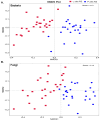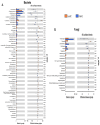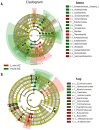Exploring the Rhizospheric Microbial Communities under Long-Term Precipitation Regime in Norway Spruce Seed Orchard
- PMID: 39273604
- PMCID: PMC11395193
- DOI: 10.3390/ijms25179658
Exploring the Rhizospheric Microbial Communities under Long-Term Precipitation Regime in Norway Spruce Seed Orchard
Abstract
The rhizosphere is the hotspot for microbial enzyme activities and contributes to carbon cycling. Precipitation is an important component of global climate change that can profoundly alter belowground microbial communities. However, the impact of precipitation on conifer rhizospheric microbial populations has not been investigated in detail. In the present study, using high-throughput amplicon sequencing, we investigated the impact of precipitation on the rhizospheric soil microbial communities in two Norway Spruce clonal seed orchards, Lipová Lhota (L-site) and Prenet (P-site). P-site has received nearly double the precipitation than L-site for the last three decades. P-site documented higher soil water content with a significantly higher abundance of Aluminium (Al), Iron (Fe), Phosphorous (P), and Sulphur (S) than L-site. Rhizospheric soil metabolite profiling revealed an increased abundance of acids, carbohydrates, fatty acids, and alcohols in P-site. There was variance in the relative abundance of distinct microbiomes between the sites. A higher abundance of Proteobacteria, Acidobacteriota, Ascomycota, and Mortiellomycota was observed in P-site receiving high precipitation, while Bacteroidota, Actinobacteria, Chloroflexi, Firmicutes, Gemmatimonadota, and Basidiomycota were prevalent in L-site. The higher clustering coefficient of the microbial network in P-site suggested that the microbial community structure is highly interconnected and tends to cluster closely. The current study unveils the impact of precipitation variations on the spruce rhizospheric microbial association and opens new avenues for understanding the impact of global change on conifer rizospheric microbial associations.
Keywords: FUNGuild; Norway spruce; PICRUSt2; amplicon sequencing; microbial communities; network analysis; precipitation; rhizosphere; seed orchards; soil metabolites.
Conflict of interest statement
The authors declare no conflict of interest. The funders had no role in the design of the study; in the collection, analyses, or interpretation of data; in the writing of the manuscript; or in the decision to publish the results.
Figures










Similar articles
-
Integrative analysis of microbiome and metabolome revealed the effect of microbial inoculant on microbial community diversity and function in rhizospheric soil under tobacco monoculture.Microbiol Spectr. 2024 Aug 6;12(8):e0404623. doi: 10.1128/spectrum.04046-23. Epub 2024 Jul 11. Microbiol Spectr. 2024. PMID: 38989997 Free PMC article.
-
[Effects of Aeration Methods on Microbial Diversity and Community Structure in Rice Rhizosphere].Huan Jing Ke Xue. 2023 Nov 8;44(11):6362-6376. doi: 10.13227/j.hjkx.202211311. Huan Jing Ke Xue. 2023. PMID: 37973118 Chinese.
-
The Structure and Function of Microbial Community in Rhizospheric Soil of American Ginseng (Panax quinquefolius L.) Changed with Planting Years.Curr Microbiol. 2022 Aug 8;79(9):281. doi: 10.1007/s00284-022-02941-2. Curr Microbiol. 2022. PMID: 35934756
-
Impacts of altered precipitation regimes on soil communities and biogeochemistry in arid and semi-arid ecosystems.Glob Chang Biol. 2015 Apr;21(4):1407-21. doi: 10.1111/gcb.12789. Epub 2014 Dec 5. Glob Chang Biol. 2015. PMID: 25363193 Review.
-
Response and driving factors of soil enzyme activity related to acid rain: a meta-analysis.Environ Sci Pollut Res Int. 2023 Oct;30(48):105072-105083. doi: 10.1007/s11356-023-29585-4. Epub 2023 Sep 20. Environ Sci Pollut Res Int. 2023. PMID: 37730980 Review.
References
-
- Malhi Y., Baldocchi D., Jarvis P. The carbon balance of tropical, temperate and boreal forests. Plant Cell Environ. 1999;22:715–740. doi: 10.1046/j.1365-3040.1999.00453.x. - DOI
-
- Martinović T., Mašínová T., López-Mondéjar R., Jansa J., Štursová M., Starke R., Baldrian P. Microbial utilization of simple and complex carbon compounds in a temperate forest soil. Soil Biol. Biochem. 2022;173:108786. doi: 10.1016/j.soilbio.2022.108786. - DOI
MeSH terms
Substances
LinkOut - more resources
Full Text Sources

